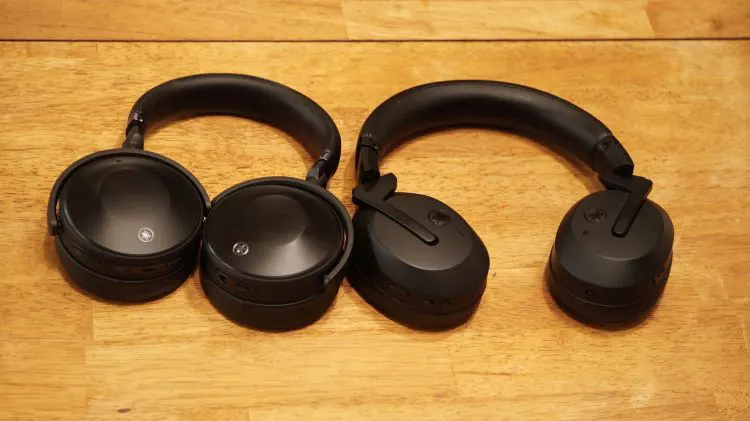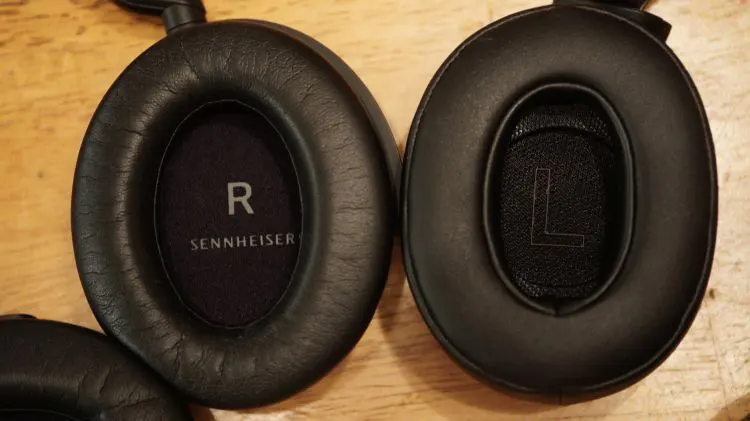Sound Impressions
Bass
The bass on the YH-E700B is lean in physical weight and it feels a bit thin and lacking in depth.
The older YH-E700A has more bottom end, the Sennheiser Momentum 4 Wireless has significantly more bass and can reach bass head levels of yumminess, and the Cleer Alpha also has significantly more bass but its bass is very harsh and impactful.
On the subject of the Momentum 4 Wireless, the bass on this Sennheiser is magnificently deep and smooth. It is the reverse with the YH-E700B, which sounds very thin, lacking substance, and depth.
The EQ potential is also lacking and the headphone doesn’t respond much to EQ at all when boosting. The Yamaha app doesn’t fix this and it is difficult to get a proper sound out of the headphone due to the technology that auto-adjusts things for you if you are not interested in disabling it.
Mids
This YH-E700B is not very forward and engaging but it is also not recessive and feels like vocals are appearing from far away from the listener.
The midrange is also lean, like the YH-E700A model. Both headphones rock a substance problem, that tonal heft or any sense of meatiness that is needed to be engaged and interested.
The Yamaha YH-E700B’s midrange cannot be changed with any EQ that easily. Similar to the YH-E700A before it, the YH-E700B doesn’t respond that well to alteration in the midrange or the upper midrange, which feels nasal and can easily become washed out the moment you add a few dB extra.
Treble
This is a slightly sibilant headphone, the top side is on the bright side in tone, but the texture is a blur at times. Especially on the lower treble and upper mid area, which have no cut-off point and blur vividly into each other.
This is not as bad of a thing on the YH-E700A, but it is so much more prominent on the fresher YH-E700B. A/B comparisons with the YH-E700A showcase the same track at roughly the same volume on wireless mode to feel noticeably less sibilant than the YH-E700B.
The treble is hostile at times. Swap to the Momentum 4, which is now sold for $50 less at $299 these days, and the difference is positively massive in quality and overall fidelity. The Momentum 4 is so much softer, firmer, thicker, weighted, engaging, vivid, and significantly more clean and clear feeling.
The YH-E700B adds a bit of nasalness on vocals between the upper mids and the lower treble that the YH-E700A model didn’t have such a problem with.
Imaging
The YH-E700B’s earpads may be ruining the experience due to their oblong design that has a much smaller cavern area for the ear to sink into, with stiff and harder pads than the YH-E700A for some reason.
The YH-E700A sounds wider and has better separation by a step or so. The new YH-E700B is lacking width factor and doesn’t sound as aired out and breathable as the cheaper model did.
The imaging field is relatively small, but coherent overall. Depth of field is the biggest problem, as I can sacrifice width and height, so long as the realism factor is good and there is plenty of depth of field and air in a stage-forward sense to my ear. That isn’t the case though. The field of view is narrow and very shallow.
Select Comparisons
Sennheiser Momentum 4 Wireless
The Yamaha YH-E700B sounds thinner and is bulkier in fit, but the Yamaha’s BT connection is significantly stronger and much more robust.
The Momentum 4 has touch controls on the cups, the YH-E700B has nothing like that. When I remove the earcups, my music disables but when I put the YH-E700B back on, the music doesn’t start up again.
Music will start again on Momentum 4 when paired with your source. The fidelity factor on the Sennheiser is a few steps ahead of this YH-E700B.
Cleer Alpha
The Cleer Alpha feels like a train blaring at you. It is immensely impactful and weighted. The hard leading edges are severe and very strong, and the bass is highly boosted and intense. To my ears, the YH-E700B is lighter, fluffier, thinner, and more sterile in approach.
Also, the headband of the Alpha leaves marks on my head while the YH-E700B does not. But so too, the pads on the Alpha are generally a bit superior in feel and quality. The YH-E700B has more active modes to use than the Alpha does.
Yamaha YH-E700A
The older YH-E700A is more of a sidestep from the YH-E700B, which should be an upgrade and 1-upping the YH-E700A in every manner of speaking, but there are some qualities that are superior to the cheaper and older model.
One of those is the imaging, which sounds much more open and realistic than the YH-E700B does. Also, comfort, the pads, and the headband on the YH-E700A are more enjoyable and feel better due to their size compared to the YH-E700B’s very small earpad opening that doesn’t fully wrap the ear.
1MORE SonoFlow
At $99, the 1MORE SonoFlow’s voice functions are better than the Yamaha but are generally on par with the YH-E700B’s overall fidelity factors across the board.
The YH-E700B has less bass and much more treble, while the SonoFlow has more bass, but a more tame and reserved treble that doesn’t feel as bright.
The build quality between both models was generally the same, in my opinion. If anything, the YH-E700B’s low latency gaming mode is the clinch winning feature over these two models.
Our Verdict
The Yamaha YH-E700B active ANC is very nice, and the battery life is superb. If you need a headphone that sounds okay and has crazy good battery life while you are on the go, then this could be a solid choice if you find it on sale soon.
For now, I think that could get squeezed out a bit with heavy competition at this price point, perhaps even by the excellent older model it replaces.
A lack of touch features and a lean tonal profile that EQ does not quite remedy even with the Yamaha app active might mean a solid demo before you try to see if this is the right wireless headphone for you.
Yamaha YH-E700B Specifications
- Type: Over-ear/closed dynamic type
- Driver diameter: 40mm
- Playback frequency band: 8Hz to 20kHz (at line input)
- Bluetooth version: 5.2
- Bluetooth compatible codec: SBC, AAC, Qualcomm aptX Adaptive/voice
- Bluetooth wireless output: Class2
- Number of devices that can be registered with Bluetooth: Up to 7
- Charging time (fully charged): 3.5 hours
- Playable time: Up to 32 hours (Advanced ANC on is up to 30 hours)
- Continuous talk time: Up to 28 hours
- Weight: 335g
- Accessories: USB power supply cable, aircraft adapter, 3.5mm stereo mini-plug cable, carrying case







